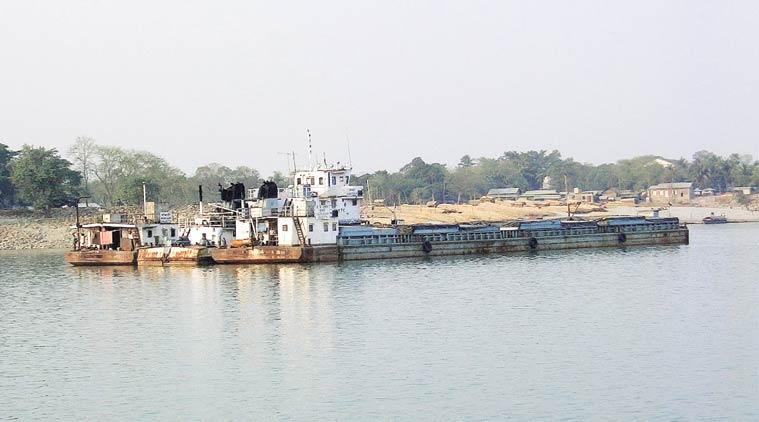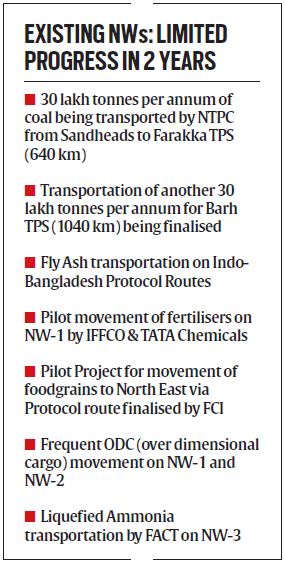- India
- International
Inland waterways policy: Dredging through the silt
Inland waterways in India makes up a paltry 3% of the total transport, compared with China's 47%; in the European Union it stands at 44%.
 Some of the important issues to be debated before the National Waterway Bill, 2015, include the point whether the declaration of a national waterway is a legislative function of Parliament.
Some of the important issues to be debated before the National Waterway Bill, 2015, include the point whether the declaration of a national waterway is a legislative function of Parliament.
The success of inland ports such as Duisburg and Nanjing, which have been competing well with sea ports, offer clear evidence of the merits of leveraging inland waterways — a far more efficient mode of transportation than either road or rail, considering that just a single mid-sized barge has the dry-cargo capacity equivalent to 50 trucks or over 10 railcars. As a consequence, transportation of cargo over inland waterways offers the advantage of both lowering carbon dioxide emissions and curbing the rate of road accidents, where India has the dubious of distinction of being among the worst in the world. Despite these tangible advantages, developing the sector in India is something that has clearly eluded policymakers, who have continued their focus on the railways and roads sectors over the years.
India is estimated to have nearly 14,500 km of navigable inland waterways, even though the exploitation of sector has remained neglected as most waterways in the country require constant dredging on account of heavy silting and draft is available only seasonally. Besides, not many entrepreneurs are willing to invest in inland vessels, which have resulted in under utilisation of whatever infrastructure is created, thereby spelling trouble for the development of the sector. In China, navigable inland waterways total more than 1,00,000 km and there are a large number of inland port facilities with berths for large vessels, with the inland waterways transportation making up to 47 per cent of the total transport available there.
 In the European Union it is 44 per cent. Inland waterways transportation in India, however, is a paltry 3 per cent. The number of vessels carrying cargo that ply on inland waterway systems in China and the EU are 2,00,000 and 11,000, respectively, while there are less than 1,000 vessels estimated to be using the Indian inland waterway systems. The crucial difference being that these countries have maintained and upgraded their river systems on core routes that can support large modern vessel fleets up to 40,000 tonnes of cargo on a single voyage, even as India is struggling to create depth in its river systems for vessels of 1,500 tonnage to go through. Even in Bangladesh, about 35 per cent of the freight movement is by inland waterways, according to ADB figures.
In the European Union it is 44 per cent. Inland waterways transportation in India, however, is a paltry 3 per cent. The number of vessels carrying cargo that ply on inland waterway systems in China and the EU are 2,00,000 and 11,000, respectively, while there are less than 1,000 vessels estimated to be using the Indian inland waterway systems. The crucial difference being that these countries have maintained and upgraded their river systems on core routes that can support large modern vessel fleets up to 40,000 tonnes of cargo on a single voyage, even as India is struggling to create depth in its river systems for vessels of 1,500 tonnage to go through. Even in Bangladesh, about 35 per cent of the freight movement is by inland waterways, according to ADB figures.
Redoubling the focus
So has anything changed? The NDA government has emphasised that developing the IWT sector is a priority, with the Union Shipping, Road Transport & Highways Minister Nitin Gadkari throwing his weight behind the sector. “I am all for developing the IWT sector and a Bill in this regard has already been moved in Parliament,” Gadkari told The Indian Express. On March 25 this year, the Union Cabinet had taken the decision to approve for enactment of Central legislation for declaring 101 additional Inland Waterways as National Waterways (NW) for navigation, something that Gadkari said “would transform the inland waterways system in the country like never before”.
 “We would ask the state governments to have a stake of 26 per cent in development of the waterways in the new Bill that would be placed in Parliament…the Centre would bear the rest of the cost,” he said. The Bill was tabled in the Lok Sabha during the Budget session and referred to the Parliamentary Standing Committee on Transport.
“We would ask the state governments to have a stake of 26 per cent in development of the waterways in the new Bill that would be placed in Parliament…the Centre would bear the rest of the cost,” he said. The Bill was tabled in the Lok Sabha during the Budget session and referred to the Parliamentary Standing Committee on Transport.

Progress on operationalising waterways and keeping them navigable, though, has been limited. So far, the Ganga, Bramhaputra, Mahanadi, Buckingham Canal between Andhra Pradesh and Tamil Nadu and the West Coast Canal in Kerala have been designated as inland waterways, entailing a total length of 4,503 km. A DPR has been prepared and work has started on the Rs 4,200 crore World Bank-assisted project to develop Varanasi in Uttar Pradesh to Haldia in West Bengal for water traffic, which will stretch upstream till Allahabad and Kanpur in later phases. Slack progress, though, is a constant theme. “Even after two decades, the waterway development remains incomplete. Targets in terms of fairway capacity, cargo, vessels and IWT operations have only declined, says former member (Technical), Inland Waterways Authority of India (IWAI), RM Nair.
Funding has been one of the biggest constraints. The 101 identified inland waterways alone require an estimated investment of Rs 35,000 crore over the next two years. State-owned Inland Waterways Authority of India or IWAI hopes to raise funds through market borrowings and organise arrangements through multilateral agencies to fund the identified inland waterways. According to IWAI chairman Amitabh Verma, domestic and foreign financial institutions are being roped in. “The IWAI has appointed a full-time consultant, who happens to be a former head of a leading Indian banking institution. The services of a senior consultant of the International Finance Corporation has also been sought. They are engaged in carving out a proposal for the creation of a consortium, amid their other assigned functions,” said Verma at a conclave in May.
Grey areas:
While the IWAI has been actively working on dredging, surveys, channel marking, river conservancy works, construction of terminals and procurement of hardware like dredgers, demonstration barges, survey launches since 1986, neither the number of cargo vessels nor the quantum of cargo movement has shown any improvement except in one case of coal movement in Haldia-Farakka stretch on the Ganga. While the new expansion plans for adding 100-odd waterways is ambitious, the experience so far on the existing waterway projects offers quite a number of red flags.
* Waterway classification — which defines the width, depth and air clearance that, in turn, dictates the size and tonnage of the vessel — is adopted in all waterways, including the Mississippi, the Rhine or Yangtze. Entire waterway or all sections of the same waterway need not be of the same class. Sustainable depth in terms of river morphology and environment should also be a the basis for classification to avoid conflicts and delays. The problem is that most of the waterways included in the list of 101 new waterways are fresh water rivers, which even dry up completely during post monsoon period. The diversion of water for navigation should not be at the cost of other priority use such as drinking and irrigation. According to Nair, unless a very detailed study is done on the balanced use of water, the 101 NW proposals is bound to face opposition from many state governments.
* Some of the important issues to be debated before the National Waterway Bill, 2015, include the point whether the declaration of a national waterway is a legislative function of Parliament.
* There are question marks over whether the state governments been taken into confidence on the proposal. Experts point to the need for setting up of Statutory Autonomous Boards with representatives of Central and state governments and technical experts for each national waterway.
Without some of these niggling issues being sorted out, the government’s new waterway thrust could well end up with the same problems facing the handful of waterways operational currently — stranded amid heavy silt and sheer a lack of impetus.
Apr 19: Latest News
- 01
- 02
- 03
- 04
- 05






































